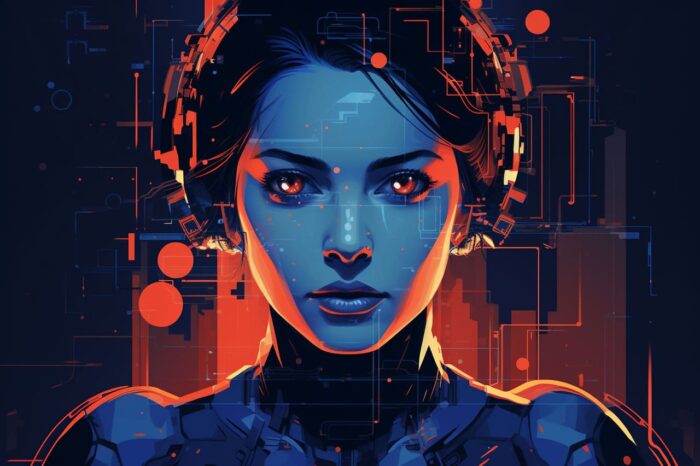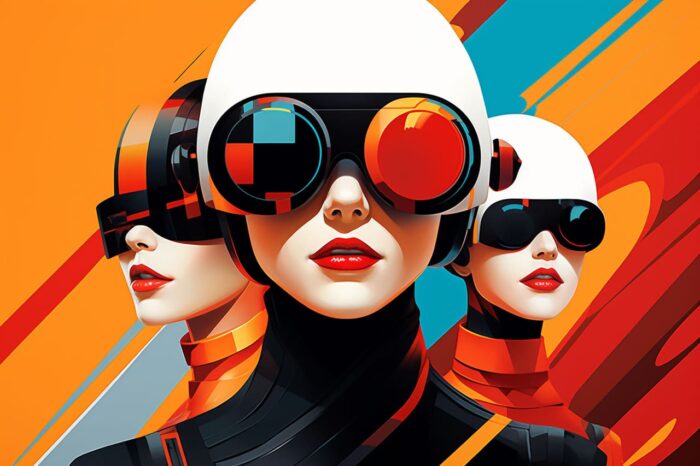Technology has revolutionized the way we think about art. From digital tools to 3D printing, the possibilities for how art can be created, displayed, and experienced have never been greater. In this article, we’ll explore how technology can be used to create futuristic illustration and sci-fi elements, transforming the traditional art landscape.
Making Art with Technology
Technology has been a game-changer for the art world. Artists can now create works of art with the help of digital tools such as graphic design software, 3D printers, and computer-aided drafting (CAD) programs. Digital tools allow artists to create works of art that would have been impossible to make in the past. For example, 3D printing can be used to make incredibly detailed sculptures that could not be made by hand.
Computer-aided drafting programs such as AutoCAD allow artists to create highly precise drawings, patterns, and designs. CAD programs are used in a variety of fields, from engineering to architecture, but they can also be used to create art. CAD programs can be used to create complex designs that would be difficult to make by hand.
Digital tools also allow artists to create art that responds to its environment. Many digital artworks are programmed to react to sound, light, and movement. These interactive artworks can be used to create immersive experiences for viewers.

Unlocking Futuristic Possibilities
Technology has opened up a world of possibilities for artists who are interested in creating futuristic and sci-fi elements. With the help of digital tools, artists can create works of art that explore the possibilities of the future. For example, some artists are using virtual reality to create immersive 3D worlds that can be explored and interacted with.
3D printing is another tool that artists can use to create futuristic elements. 3D printing can be used to create complex shapes and structures that could not be made by hand. This allows artists to create intricate objects that could be found in a science fiction movie or video game.
In addition to digital tools, artists are also experimenting with augmented reality (AR). AR allows artists to create art that interacts with its environment. For example, some artists are using AR to create 3D sculptures that respond to motion and sound. This allows viewers to interact with the sculpture and explore it from different angles.
Illustrating Sci-Fi Elements
Technology has allowed artists to create works of art that explore the possibilities of science fiction. Many artists are using digital tools to create works of art that explore futuristic themes and ideas. For example, some artists are using 3D printing to create sculptures inspired by science fiction movies and video games.
Computer-aided drafting programs are also being used to create art inspired by science fiction. CAD programs can be used to create highly detailed drawings and patterns. These drawings can be used to create abstract works of art that explore sci-fi themes and ideas.
In addition to digital tools, many artists are using traditional media to illustrate sci-fi elements. For example, some illustrators are using pencils and paints to create detailed drawings of futuristic worlds and creatures. This allows them to create works of art that explore the possibilities of science fiction in a traditional medium.
Transforming the Art Landscape
Technology is transforming the traditional art landscape. Digital tools are allowing artists to create works of art that would have been impossible to make in the past. Artists are using digital tools to create works of art that explore futuristic and sci-fi elements and to create immersive experiences for viewers.
Technology is also allowing artists to push the boundaries of what is possible. Digital tools are enabling artists to create works of art that explore the possibilities of the future. In addition, artists are using traditional media to create works of art that explore sci-fi themes and ideas.
Technology is transforming the art landscape and allowing artists to create works of art that were previously impossible. From digital tools to 3D printing, technology is unlocking a world of possibilities for artists to explore and create new and exciting works of art.
Famous Futuristic Illustrators
Futuristic illustration is a genre of art that envisions and depicts the future in imaginative and creative ways. Here are some famous futuristic illustrators known for their visionary work:
Syd Mead
Perhaps one of the most iconic futuristic illustrators, Syd Mead is renowned for his work on films like “Blade Runner,” “Tron,” and “Aliens.” His designs seamlessly blended technology and humanity, creating visually stunning and immersive worlds.
Arthur C. Radebaugh
Arthur C. Radebaugh was known for his illustrations of a utopian future in the 1940s and 1950s. His work featured streamlined cars, futuristic cities, and automated homes, reflecting the optimism and aspirations of the mid-20th century.
Moebius (Jean Giraud)
Moebius was a French artist celebrated for his surreal and otherworldly illustrations. His work often transcended traditional sci-fi, diving into the realm of fantasy and dreamlike landscapes. His artistry inspired many filmmakers and artists.
Chris Foss
Chris Foss is known for his distinctive spacecraft and vehicle designs, particularly in the realm of science fiction book covers. His work has graced the covers of books by authors such as Isaac Asimov and Arthur C. Clarke.
H.R. Giger
While primarily famous for his nightmarish and biomechanical designs in the “Alien” film series, H.R. Giger’s work is undeniably futuristic and has left an indelible mark on the sci-fi genre.
John Berkey
John Berkey’s space and science fiction illustrations are characterized by their grand, sweeping vistas of futuristic cities, space stations, and interstellar landscapes. His work has been featured in various sci-fi novels and magazines.
Ron Cobb
Ron Cobb was a conceptual designer and illustrator known for his work on films like “Star Wars,” “Alien,” and “Back to the Future.” His futuristic designs and attention to detail contributed significantly to the visual aesthetics of these films.
Roger Dean
Roger Dean is famous for his album cover artwork for progressive rock bands like Yes and Asia. His fantastical and otherworldly landscapes often feature intricate architectural and natural elements.
Kim Stanley Robinson
Kim Stanley Robinson is a science fiction author who has collaborated with artists like Marta Thoma to produce illustrations for his novels. Their work captures the essence of imagined futures in Robinson’s books.
These illustrators have not only shaped the way we envision the future but have also contributed to the visual language of science fiction and futuristic storytelling across various mediums, including film, literature, and art.
Futuristic Fashion Illustration
In the realm of futuristic illustration, where the imagination knows no bounds, one subgenre stands out as a captivating fusion of art, technology, and style – Futuristic Fashion Illustration. Here, artists weave together the threads of creativity and foresight to craft visions of clothing, accessories, and personal adornments that transcend the constraints of time and tradition.

Defying Conventions
Futuristic fashion illustration is a realm where the ordinary gives way to the extraordinary. It defies the conventions of contemporary attire, replacing them with bold, avant-garde designs that challenge our perceptions of what clothing can be. These illustrations are not merely about clothing; they are about self-expression, innovation, and the limitless possibilities of the future.
Innovative Materials
One of the hallmarks of futuristic fashion illustration is the imaginative use of materials. Here, fabric takes on new forms and functions, thanks to advancements in technology and material science. Garments may shimmer with holographic textiles, respond to changes in the environment, or even incorporate sustainable and eco-friendly materials that harmonize with the planet.
The Marriage of Fashion and Technology
In this world, fashion and technology become inseparable dance partners. Futuristic fashion illustrators envision clothing that interacts with its wearer, responding to physiological cues or environmental conditions. They explore the integration of augmented reality and wearable tech, transforming garments into immersive experiences.
Pushing Aesthetic Boundaries
Aesthetic boundaries are pushed to their limits in futuristic fashion illustration. Designs range from sleek and minimalist to extravagant and avant-garde. These illustrations challenge our understanding of beauty and aesthetics, often blurring the lines between fashion, art, and architecture.
Environmental Consciousness
Sustainability also finds a place in futuristic fashion illustration. Many artists envision clothing that not only looks stunning but also has a minimal impact on the environment. Concepts like zero-waste fashion, biodegradable materials, and clothing that generates energy or purifies the air become part of this imaginative landscape.
A Source of Inspiration
Futuristic fashion illustration isn’t confined to the realms of sci-fi and fantasy. It often serves as a wellspring of inspiration for designers, fashion houses, and creators in the real world. Elements from these illustrations frequently find their way into haute couture, avant-garde fashion shows, and even everyday streetwear.
A Glimpse into the Future
Ultimately, futuristic fashion illustration offers us a tantalizing glimpse into the future of clothing and personal style. It encourages us to shed the limitations of tradition and embrace the boundless potential of creativity. It reminds us that fashion is not just about covering our bodies but expressing our identities, our aspirations, and our visions of a world where the future is as limitless as our imagination.
As we navigate the rapidly evolving landscape of fashion and technology, let’s not forget the dreamers and visionaries of futuristic fashion illustration who beckon us to explore the uncharted territories of style. They remind us that the future of fashion is not a destination but a journey, and the path is illuminated by the artistry of those who dare to dream beyond the confines of the present.